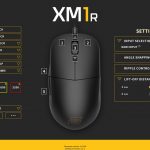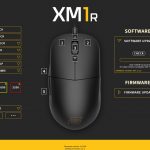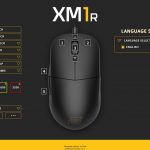To test the XM1r, I used it as my daily driver for just over a week. We break down testing into three main sections: software, build quality and comfort, and performance.
Software
The first thing you need to know about the XM1r's software is that it is currently still in beta and you cannot download it from the downloads section on Endgame Gear's website. Instead, a download is available through the company's Discord server, which you can join HERE. This is somewhat inconvenient as it is not directly advertised on Endgame Gear's website, while users who buy a mouse may not necessarily have a Discord account. Primarily, though, the XM1r was first announced at the tail-end of 2020 – so why is the software still in beta, almost nine months on?
That aside, the beta software is at least more fully-formed that the software that launched alongside the original XM1. Buttons can now be remapped to other functions, such as media controls or keyboard keys, while there is also a choice of lift off distance settings. Angle snapping can also be enabled or disabled, and up to five profiles can be configured and then saved to the mouse's on board memory.
Where we can see that the software is still very much in beta, is by the fact that despite having an option to change language, English is the only option available. The firmware update tool also doesn't function correctly, as it updated my mouse to V 1.8.40, when 1.8.154 is the latest firmware update available.
Ultimately, there is clearly still room for improvement here, and I can't quite understand why a finished version of the software is yet to appear, so long after the XM1r first launched. That said, for many – including myself – the beta software is good enough to be able to set your desired DPI stages, adjust LOD and angle snapping and so on, save the settings to a profile, and then uninstall the software. It provides enough control now to be useful, but saying anything more than that would be too generous to Endgame Gear in my opinion.
Build quality and comfort
I noted in my XM1 review that, despite the low 70g weight and the fact that the mouse weighs that much without riddled with holes, the build quality is pretty much faultless. I am pleased to say the same applies to the XM1r. There is no noticeable rattle when picking up the mouse and shaking it, you can't engage the side buttons by squeezing either the top or sides of the mouse, nor is there any noticeable creaking from the shell while doing so. It really is very solidly built and I just can't leverage any complaints here at all.
Likewise, using the same shape as the XM1 means I find the XM1r to be extraordinarily comfortable. I've actually been using the original XM1 since I first reviewed it for that very reason, even if other mice have come along since with a more flexible cable or newer sensor, the shape is just perfect for me.
I use a claw grip primarily, and with the wide back on the XM1/XM1r, I find I just have some much support for the back of my palm, it really allows me to anchor my hand on the base of the mouse and get a good amount of reach with my thumb and fingers. So I'd say a claw grip is ideal for the XM1, though I could also see palm grip working too. For fingertip users, I just wonder if the mouse is too wide for finger tip to be as comfortable as on something like the Glorious Model O or O-.
With the new semi-transparent Dark Frost design, Endgame Gear has also improved on the area which I criticised in my XM1 review, that of the mouse's coating. I found the XM1's coating to be very good for grip, but it showed all kinds of grease and skin oils incredibly easily, resulting in a rather unpleasant-looking mouse if you didn't clean it every five minutes.
Now with the XM1r, I actually find the mouse to be even gripper than the XM1, but the coating on my Dark Frost model also shows significantly less grease or skin oil residue. You can still see a little of this, particularly if you hold the mouse up to a light source, but after several hours of Call of Duty: Warzone, the XM1r looked almost as good as when I first took it out of the box, whereas the XM1 starts to look very gross, very fast.
Performance
Let's talk now about mouse performance, starting with the primary buttons. These use Kailh GM 8.0 switches and they are very good. Fantastic even. First of all, there is essentially no pre-travel – the switches actuate basically as soon as downward pressure is applied to the shell, but before the shell has depressed. It's a lovely feeling. There is also just a very small amount of post-travel, though this is only really noticeable if you are applying an unreasonable amount of force to the buttons. Click them normally, as if you were playing a game, and you won't notice the post-travel.
Compared to the Omrons in the XM1, the Kailh GM 8.0 switches definitely have more of a tactile bump, with the Omron's feeling a touch softer and slightly mushier (though only slightly.) The GM 8.0 switches have also been pre-sorted by Endgame Gear to reduce tolerances, so these offer a 55-60gf actuation, so that's a maximum of 5gf variation between switches. That results in both primary buttons having a very uniform feel, with no noticeable variation between the two.
Additionally, the buttons still use Endgame Gear's patented analog technology, which the company claims ‘implements an advanced algorithm to drive faster click detection for a reaction time of less than 1ms.' This was also present on the XM1, and to be perfectly honest I struggle to tell the difference between this and any other high quality gaming mouse. However, that means I had no issues at all with perceived click latency and didn't experience any double clicks, so I really cannot complain.
Likewise, the side buttons on the XM1r are a noticeable improvement over the XM1. Overall pre- and post-travel is similar, as they are using the same shell design, but the TTC switches in the XM1r are noticeably snappier and also tighter – the XM1 side buttons feel much looser in comparison.
In terms of the scroll wheel, it's another excellent area for the XM1r. The scrolling experience feels the same to me as with the XM1, and as both models use an ALPS encoder and – as far as I can tell – the same physical wheel, so that is likely why. The scroll click is significantly lighter on the XM1r, though, making it much easier to press. I typically use scroll click for melee in Warzone, and it does make a noticeable difference when you're trying to bash someone to death before they can bash you back.
One area where the differences aren't as large is with the sensor. Both the PAW 3370 and PMW 3389 are top quality sensors, and in terms of tracking and overall sensor accuracy, I really couldn't tell these apart – though that is definitely a good thing, as it means we're just not running into any tracking issues on either mouse.
The PAW 3370 does offer lower lift-off distance (LOD), however. By default it is set at 1mm, though this can be raised to 2mm in software. Using the former setting, the XM1r would not track when raised 1 DVD height from my HyperX FURY mousepad. Using the 2mm LOD, it would track at 1 DVD high, but only tracked intermittently at 2 DVDs high.
Lastly, the cable is another interesting area for the XM1r. The original XM1 released with a rubber cable, and the shoelace style cable here is miles better – more flexible and less prone to kinking. The XM1, however, was also re-released with the so-called Flex Cord, another paracord style of cable. Compared to Flex Cord, the XM1r which uses Flex Cord 2.0, does feel slightly stiffer overall, so that would seem like a backwards step to me. It is still very flexible, but it's just not as good as the first generation Flex Cord. We are told that Flex Cord 2.0 is meant to be more durable, but it's hard to know if Flex Cord 1.0 had any real issues – it certainly hasn't proved that way in my usage.
 KitGuru KitGuru.net – Tech News | Hardware News | Hardware Reviews | IOS | Mobile | Gaming | Graphics Cards
KitGuru KitGuru.net – Tech News | Hardware News | Hardware Reviews | IOS | Mobile | Gaming | Graphics Cards





